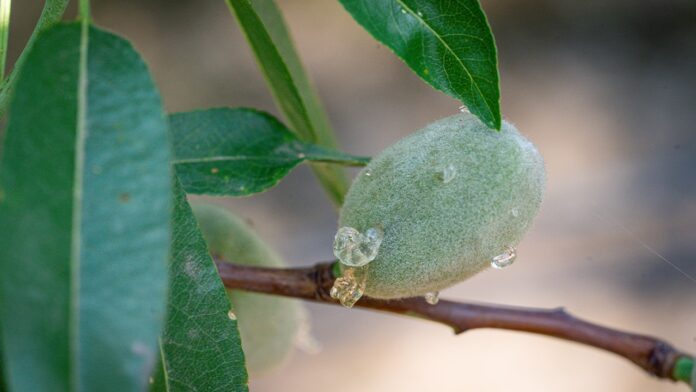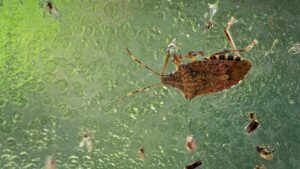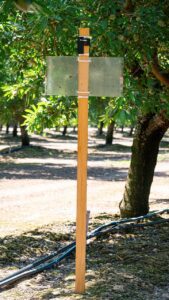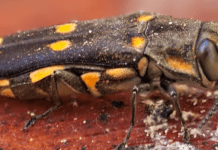
One of the biggest tasks for almond growers each growing season is pest management. Growers must stay informed and vigilant on new and existing pests and understand how to deal with insects that can possibly threaten their crop.
Plant bugs, for example, are not a new pest for most almond growers but are quickly becoming a widespread issue in the industry. Over the last five years, PCAs have witnessed increasing pressure from these insects, and they are finding their effects can linger from year to year.
The leaffooted bug, brown marmorated stink bug and boxelder bug are the main insects from the plant bug family that find their way into almond orchards. They damage the nuts, causing decreased yields and harvest rejects and in turn leaving behind dollars in the field instead of in the pockets of growers.
The good news is damage can be kept to a minimum if these pests are diligently monitored, said Mateo Marquez, PCA at Integral Ag.
What Damage Looks Like
Damage caused by a plant bug is not linear. When a plant bug punctures a nut with its piercing, sucking mouthparts, the nut is not only physically damaged but also chemically damaged. This can occur either prior to shell hardening or post shell hardening, Marquez said.
Prior to shell hardening, growers will notice damage has been done when some nuts begin turning yellow and eventually fall off the tree. After shell hardening, those damaged nuts are more likely to remain on the tree and hull split early. Gumming will start on the inside of the kernel that eventually becomes a brown spot.
“Plant bug-damaged nuts that stick in the tree tend to hull split early, as much as 14 or more days before healthy nuts hull split,” Marquez added.
Additionally, what experts are seeing is these nuts that split early can create a host site for navel orangeworm (NOW) by giving it an entry to cycle through the orchard and exacerbate a NOW issue.
Signs and Symptoms
Marquez noted identification is the “most important fundamental” when it comes to monitoring, and although tedious and time consuming, field scouting is the most effective way to discover a problem. As a proven gold standard practice for decades, it’s often obvious from year to year when a field has been scouted consistently.
Additionally, signs and symptoms are helpful clues, but they don’t always tell the whole story, especially when assessing the temporal aspects of the damage. That’s why frequent, regular checks help growers and PCAs understand the issue at hand without having to fill in the gaps.
Each plant bug has different characteristics that make it detectable in the orchard. Spotting the insect itself is the goal, Marquez said, but there are also telltale signs that can be useful for identification.

The most common symptoms a grower should look for are gummosis on the sides of the nut, a puncture or hole through the shell resulting in damage to the developing nut, and egg masses along the shell.
It’s also important to note what aren’t plant bugs. Beneficials like the rough stink bug and the assassin bug can often be found in the field and easily mistaken for a harmful plant bug.
Likewise, signs and symptoms that appear as evidence of a plant bug can actually be nutrient deficiency or a diseased tree. Marquez expressed the importance of knowing the difference before making a treatment decision.
Tips for Monitoring
So how can growers know what to look for when it comes to monitoring for plant bugs? Marquez outlined a few tips to help growers recognize what’s happening in their orchards.
Know the field history. Visit the field frequently and take notes. “If you had a block that had problems this year, there’s a good chance it had problems frequently in the past,” Marquez explained.
Assess nearby overwintering sites. Are you near a riparian or residential area? Plant bugs love to overwinter on structures or landscaping plants, so blocks of orchards near these areas can see increased damage if not actively monitored.
Look at the sunny sides of trees, especially in the mornings. Because insects do not generate their own heat, they will often be exposed where the sun is shining.
Concentrate on edges. “UC research has shown damage dissipates as you move into the orchard when it comes to plant bug damage, so the edges are really where you want to focus your attention,” Marquez noted.

Use a long stick or pole to knock branches. Trying to scan every nut on a tree can be very time-consuming, so this method can help speed up the process.
Use all your senses. Sometimes what sight cannot catch, smell or hearing can. For example, some plant bugs can put off a recognizable odor, and the clicking sounds they make can be very distinct.
Some varieties are more susceptible to damage than others. If you are a grower growing Independence, Aldrich, Monterey or Butte trees, know that these varieties are frequently targeted.
Treatment Options
If a plant bug problem is found in an orchard, it’s first important to consider how severe the infestation is and determine a plan of action for applying chemicals.
There are different options of chemicals for growers to choose from, but most opt to use a pyrethroid. While pyrethroids are the most effective and economical option, they also are the most broad-spectrum. This may result in pairing it with another chemical, which ultimately raises the treatment cost, Marquez warned.
Another option is clothianidin, a softer chemical that has less impact on beneficials and is found in pyrethroid alternatives, although it does not have the same residual effect and can require retreatment of fields.
Generally, chemical applications can be tricky depending on if it occurs prior to or after shell hardening. Marquez recommended assessing the issue at hand to determine if application can be delayed or combined with another chemical treatment to save the grower time and money.
“If it’s before the shell hardening period, the nuts that get stung are not going to end up in your grade,” he said. “While you’re going to lose some nuts, if it’s not that bad, we can delay until we know we’re going to have to spray for navel orangeworm or whatever treatment that’s coming up.”
Some growers with mixed varieties in their orchard can also cut time and costs by only spraying the varietal most prevalent to plant bug damage, Marquez suggested.
Adding to this challenge are the regulatory restrictions on chemical use coming down the pipeline. Marquez explained there is a potential for pyrethroids to be eliminated as a treatment method all together if this happens.
However, on a positive note, a new pheromone monitoring lure is currently in development, with hopes of making this process more streamlined for growers and PCAs alike, Marquez said. This product also has the potential for an “attract and kill program,” which sets out a specific number of traps per acre as a treatment instead of spraying.
Future Outlook
It’s no secret that plant bug pressures are undoubtedly increasing, so growers must take initiative on scouting their orchards and driving preventative and proactive measures before a problem arises.
“If you remember one thing from this, it’s to take time to scout your fields,” Marquez concluded. “That’s really what’s going to save you when it comes to plant bugs.”










